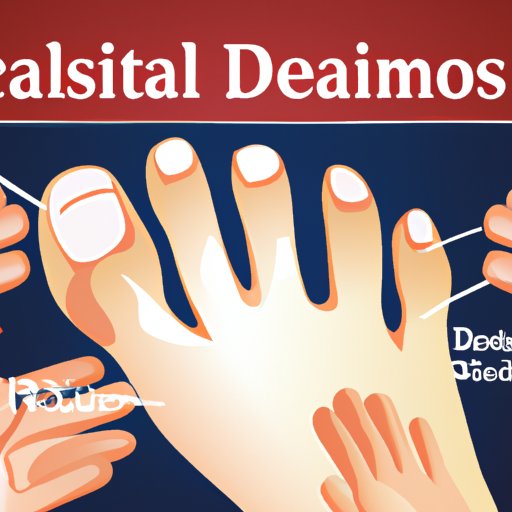
Introduction
Hand, Foot, and Mouth Disease, or HFMD, is a common viral infection that primarily affects children. The highly contagious disease is known for causing painful blisters on the skin and mouth, which can lead to difficulty in eating and drinking. While most cases of HFMD resolve on their own, some cases may require medical attention. It is important to understand the symptoms, prevention methods, and treatment options for HFMD to prevent the spread of the virus and minimize its impact on individuals.
General Overview of HFMD
HFMD is a viral infection caused by enteroviruses, most commonly the Coxsackie virus. The virus is spread through close contact with an infected person, through respiratory secretions and fecal-oral contact. The virus typically enters the body through the mouth or nose, then spreads through the bloodstream to the skin and mucous membranes.
While HFMD may occur at any time throughout the year, it is most common during the summer and early fall. The disease is found globally and is common in Asia, Africa, and Europe. The virus is most prevalent in children under the age of 5, but can still affect people of all ages.
The symptoms of HFMD typically occur within three to five days of exposure to the virus. Common symptoms include fever, sore throat, headache, and a rash with characteristic blisters on the hands, feet, and mouth. In some cases, individuals may experience vomiting, diarrhea, or abdominal pain.
Prevention and Spread of HFMD
Practicing good hygiene is the best way to prevent the spread of HFMD. Frequent hand washing with soap and water, especially after changing diapers and before preparing food, can significantly reduce the likelihood of infection. Avoiding close contact with infected individuals is also another way to minimize infection risk.
Disinfecting frequently touched surfaces, such as toys, doorknobs, and light switches, can help kill the virus and prevent its spread. Symptoms of HFMD can take time to manifest, so it is essential to avoid close contact with individuals who have recently travelled to areas where the virus is prevalent.
Early detection is crucial in preventing the spread of HFMD. Any individual who is showing symptoms of the virus should avoid close contact with other individuals until they have been cleared by a medical professional. It is important to note that individuals infected with the virus can continue to spread the infection for weeks after their symptoms have resolved.
Symptoms and Treatment of HFMD
The symptoms of HFMD can vary from one individual to another and may depend on the severity of the virus. The most common symptoms of HFMD include fever, sore throat, headache, and a rash with small, painful blisters on the hands, feet, and mouth. In some cases, individuals may also experience vomiting, diarrhea, or abdominal pain.
Treatment for HFMD is primarily aimed at managing the symptoms, as the virus typically resolves on its own. Over-the-counter medications such as acetaminophen or ibuprofen can help alleviate pain associated with fever and body aches. Drinking plenty of fluids, including water and sports drinks, can help prevent dehydration. Additionally, it is essential to avoid acidic or spicy foods, which can irritate blisters in the mouth.
It is important to seek medical attention if you or someone you know exhibits signs of severe HFMD. In rare cases, the virus can cause meningitis (inflammation of the brain and spinal cord), encephalitis (infection of the brain), or a polio-like illness known as acute flaccid paralysis. Parents of young children should be especially vigilant as they are more susceptible to severe complications.
Outbreaks in Schools and Daycares
HFMD outbreaks in schools and daycares are a common occurrence. Young children in these settings are particularly vulnerable, as the virus spreads quickly in close-contact environments such as these. To prevent these outbreaks, it is essential to enforce good hygiene practices and to maintain a clean and disinfected environment.
If a child is infected with the virus, it is essential to keep them away from school or daycare for at least seven days. Parents should be on the lookout for symptoms and keep their children home if they exhibit any of the symptoms of the virus.
The Long-Term Impact of HFMD
In most cases, HFMD resolves on its own without any long-term effects. However, in rare cases, the virus can lead to long-term complications. One of the most severe complications is Guillain-Barre syndrome, a disorder that causes muscle weakness and paralysis. This condition typically occurs in patients who have had HFMD caused by enterovirus 71.
Other long-term complications of HFMD include viral meningitis and encephalitis. These conditions can cause severe brain swelling and, in rare cases, lead to coma or death. It is important to seek medical attention if you or your child exhibits any of the symptoms associated with these severe complications.
Conclusion
HFMD is a common viral infection that can cause a great deal of discomfort and pain. Understanding the symptoms of the disease, prevention methods, and treatment options are crucial in managing the virus. Practicing good hygiene, avoiding close contact with infected individuals, and keeping a clean and disinfected environment are effective ways of preventing the spread of the virus. Although HFMD typically resolves on its own, it is essential to seek timely medical attention in case of severe symptoms suggestive of serious complications.
The best way to combat HFMD is through proper education and prevention. By following the steps outlined in this article, individuals can reduce their risk of contracting the virus and minimize its impact on their health and well-being.




